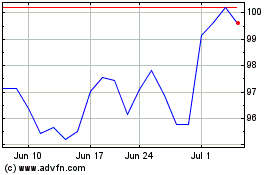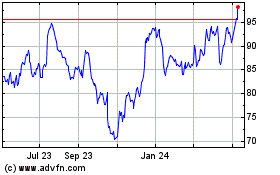By Eric Uhlfelder
A buying opportunity may be shaping up in the $750 billion
market of U.S. preferred shares.
This relatively obscure asset class has taken a hit during the
second half of the year, with individual preferreds correcting 10%
to 20%. Industry observers felt these securities -- hybrids between
stocks and bonds that are prized for their income -- were due for a
reckoning of sorts after having held up too well while the Federal
Reserve raised rates over the past several years. Like all
fixed-income securities, when interest rates rise, preferred prices
tend to fall.
A key reason why preferreds sold off during the second half of
the year was the spike in 10-year Treasury yields. This is the
benchmark rate that most directly affects preferred pricing, says
Barry McAlinden, a senior credit strategist in UBS's Chief
Investment Office.
"We don't think this yield will move meaningfully above its 2018
peak of 3.2% over the next year," says Mr. McAlinden, "which should
bode well for preferreds."
This is generally in the ballpark with most near-term calls for
10-Year Treasury yields. Several years out could be a different
story, with Jeffrey Gundlach, chief executive officer of DoubleLine
Capital, being one of the most bearish, calling for a sharp rise in
10-year yields to 6%. That would not be good news for existing
fixed-rate preferreds.
However, over the past two months, the yield of the 10-Year
Treasury has sharply declined from 3.23% to 2.85%. Meanwhile,
preferred prices continue to fall and their yields continue to
rise.
For investors who feel interest-rate rises will be contained for
a while and the greater fear is more of a slowing rather than an
overheating economy, then preferred shares may be a good source of
income. For investors who fear interest rates will continue to rise
across the board, then they should stay away from most preferred
stocks.
Preferred shares are a kind of cross between exchange-traded
stocks (that you can easily buy online) and bonds whose prices
fluctuate with interest rates and credit risk. Investors buy
preferreds for their income, rarely for capital gains.
Though they've been around for decades, this asset class is
underresearched and not well understood.
A key benefit many preferreds have over bonds is their yield is
typically higher than bonds, and the dividends they pay are taxed
at a much lower rate than debt. Bonds pay interest, which is taxed
at a higher rate.
An example of such a preferred, which UBS recommends, is State
Street Capital's preferred E shares. It has held up better than
most preferreds, currently yielding 6% after its price declined
from $26.55 in July to $25.07 in early December. The dividend of
this investment-grade preferred is taxed at the low
qualified-dividend-income rate of 15% to 20%. It can be initially
called (bought back) by State Street in December 2019 at $25. But
investors would still net a 5.6% return and a small tax loss.
Another point to keep in mind: Preferred prices don't move in
lockstep with stocks -- in Wall Street parlance, they are less than
half "correlated" with common stocks, according to Kevin Conery,
analyst on the preferred trading desk at Piper Jaffray. This means
if the market continues to tumble and rate increases are
constrained (which is more likely if stocks continue to fall),
preferreds might be a better store of value than stocks.
Understanding preferreds
Where corporate bonds pay interest twice yearly, preferreds pay
quarterly dividends. And according to Cohen & Steers, a $58.5
billion asset manager, investment-grade preferreds offer the
highest pretax average yields (6.0%) of any income asset class,
save for junk bonds (6.7%). Municipal bonds are yielding 4.4%,
investment-grade corporate bonds are paying 4.2%, and 10-year
Treasurys are delivering 2.85%.
Preferred dividends must be paid before those of common shares,
but their credit ratings are several notches below senior unsecured
debt.
These securities come in many different shades. Many come with
fixed coupons, others with floating rates, and then there are those
with yields that will shift from fixed to a floating rate. Some
offer preferential tax income treatment for individuals and
corporations. The majority never mature (called perpetuals), but
all can be called by their issuers five or 10 years after they come
to market, and at any point thereafter.
Preferred yields are higher than those on bonds because, among
other things, most preferreds don't mature, thus not guaranteeing
repayment at par like bonds do, and their dividends can be missed
without triggering a default.
But when dealing with financially solvent companies, Mr. Conery
says, "firms will tap every possible resource to avoid that
dividend miss." The reason: Missing dividend payments will drive up
the cost of capital due to the perception that the issuer is
suffering from mounting financial worries.
A small portion of preferreds do offer some protection against
missed dividends. These are called cumulative shares, which means a
company cannot restart payment of a common dividend until it repays
all missed dividends of its preferreds.
Public Storage, the real-estate investment trust that builds
storage facilities across the country, issued a bunch of such
preferreds. Its Series E, whose dividends aren't eligible for the
lower QDI rate, fell sharply since September from $24.59 to $20.84,
yielding 5.88%. Though callable in November 2021, investors would
enjoy an annualized return of 12.35% if it's called at $25, because
capital gains get factored into the return.
What moves prices
In addition to 10-year Treasury yields, pricing is determined by
the spread over these yields, which varies based on demand for
preferreds and a long view of interest rates. Credit risk also
moves prices.
Shipping-related preferreds typically are considered
higher-than-average credit risk plays because of uncertain,
volatile charter rates they're able to charge clients. Though
growing global trade tensions are directly impacting shipping,
these preferreds offer very high yields for investors who believe
in the long-term underlying buoyancy of a shipping company.
Such a play could be Seaspan, which leases container ships it
owns. Seaspan securities aren't rated because the firm has been
able to raise capital without a credit rating. Its series G
preferreds are currently yielding 8.53% after their price fell from
nearly $26 in early September to $24.04. The dividend is both tax
qualified and cumulative. It's callable in 2.5 years. So if the
firm can refinance at a cheaper rate than its 8.2% coupon --
currently the highest on the firm's books -- then this preferred
would likely be the first one the firm would call, also creating a
capital gain for a new investor.
While he figures 10-year Treasury yields will not likely exceed
3.5% over the next year, William Scapell, manager of the $7.5
billion Cohen & Steers Preferred Securities & Income Fund
(CPXAX), favors quality fixed-to-floating rate (three-month Libor
plus 4 percentage points) issues that can provide longer-term
interest-rate protection.
One such security on UBS's attractive list, despite a credit
rating just below investment grade, is Morgan Stanley Series E
preferred. It has slipped $2 since August to $26.76, currently
yielding 6.70%. And if it's not called in October 2023, its
variable rate could yield more than 7% based on current three-month
Libor plus its 4.32 percentage-point spread. If it's called,
investors will still walk away with an annual return of over
5.5%.
Like all investing, buying preferreds requires substantial
understanding of a company's finances and risks. Because preferreds
are less liquid than common shares, investors should use limit
orders when buying and selling, always mindful of ex-dividend and
call dates. A good, free place to start researching preferreds is
Quantumonline.com.
Cohen & Steers, Invesco, Nuveen and Principal have large,
seasoned preferred funds that have generated net annualized yields
between 5% and 6% over the past five years. But funds with sales
charges will negate this edge over the near term. Closed-end funds'
use of leverage, which increases yield, makes their prices more
volatile.
Mr. Uhlfelder writes about global capital markets from New York.
He can be reached at reports@wsj.com.
(END) Dow Jones Newswires
December 09, 2018 22:19 ET (03:19 GMT)
Copyright (c) 2018 Dow Jones & Company, Inc.
Morgan Stanley (NYSE:MS)
Historical Stock Chart
From Mar 2024 to Apr 2024

Morgan Stanley (NYSE:MS)
Historical Stock Chart
From Apr 2023 to Apr 2024
